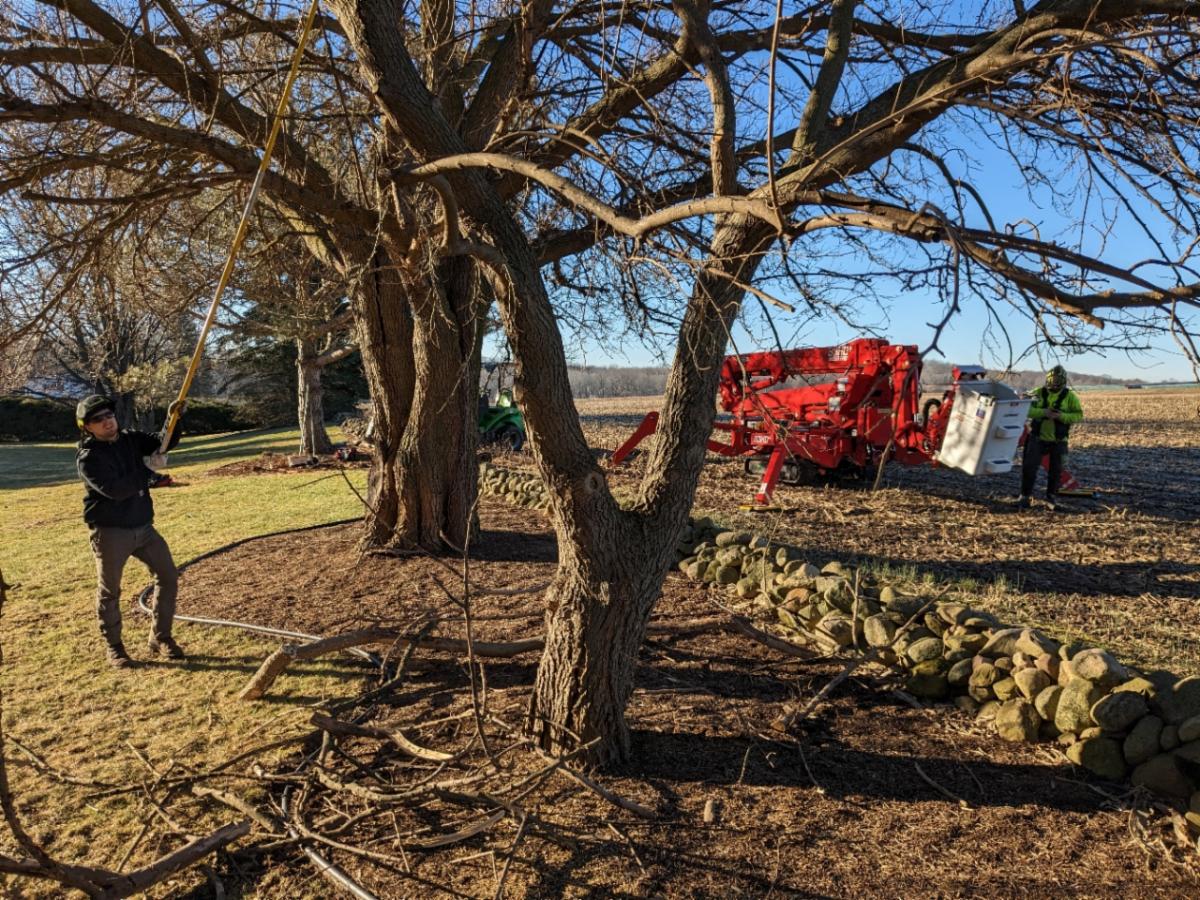To Prune or Not to PruneWhen is the right time to prune your fruit tree? |
At this time of year, more light and bits of color are returning to our landscape. Along with the sun and fresh colors comes the nostalgia of seasons past, the smell of spring, the heat of summer, and the feel of flannel in fall. While these sensations may bring back memories of get-togethers and outdoor excursions, they may also bring your spring to-do list front of mind. One item on many people’s lists is to get their yard ready. That usually includes having your shrubs, hedges, and ornamentals dolled up. It is time to prepare for pruning! |
 |
Our crew pruning pear trees. The major goals were improving structure and increasing clearance from the house. |
Let's start with why people prune trees. There are three main reasons for pruning trees and woody plants— safety, health of the tree, and aesthetics. Safety pruning removes old, naturally occurring dead wood and addresses future potential failures of unstable limbs. Pruning for health addresses removing deadwood, which helps the tree focus energy on viable and healthy branches. Pruning for health also dials in on removing crossing/rubbing branches to prevent wounds to the bark that would leave the tree exposed to pest attacks. Removing diseased and infected limbs will help keep your trees healthy. Pruning is also done for aesthetic reasons. This can be done to promote flowering and the overall appearance of the tree. Regardless of the reason for pruning, it is important that all pruning is done properly and at the correct time of year. Your arborist will help you meet your objectives by applying their knowledge of how the tree will respond to the various pruning options. |
 |
The crew performing a winter prune on mulberries. |
Let's now focus on fruit trees and the best time to prune them. You can prune most fruit trees at any time of year. It all comes down to what your main pruning goals are. Generally, we recommend pruning your fruit trees in the winter to early springtime. Below are some additional considerations to determine the best time to prune. Early Spring Pruning – This is a great time to prune as your tree is just starting to jump back into photosynthesis. Buds will be breaking in the next few weeks. Your tree will have plenty of time to respond to pruning cuts properly. Be aware that when you remove live branches, you are removing food that the tree has stored in those branches. If your objective is to produce fruit, then you need to be aware that removing too many branches in early spring can lead to lower fruit yields. Summer Pruning – You do not want to remove major limbs at this time. Removing too many branches can expose the trunk and fruit to sunburn due to having fewer leaves to protect the tree. Trees can get sunburned! These leaves are also generating food for the tree, which is used to produce its fruit. However, it is a good time to do minor pruning that will help maintain proper structure. Summer pruning is not recommended if producing fruit is important to you. Fall Pruning—It is not recommended to prune while the tree is fruiting. This can put stress on the tree. If fruit is important to you, then we recommend that the only type of pruning that you do in the Fall is for safety or hazard reasons. Winter Pruning – This is usually the perfect time for large pruning projects because the tree is dormant. You can see the complete structure of the tree with no hidden parts. Dormant pruning can reduce the chance of pest and fungal attacks. |
 |
Call (585) 617-0564 to book an appointment with our certified arborist. |
It is important to select an arborist who knows the proper times to prune for specific species. We at Monster Tree Service of Rochester keep overall tree health as a top priority of care when pruning. If you have any questions about fruit trees or pruning in general, please feel free to reach out to us by visiting our website. For additional information about fruit trees and pruning visit: How long before my new tree produces fruit? Pruning Apple Trees-- Cornell Cooperative |
 |
Be sure to visit the Monster Tree Service of Rochester team at the Roc Home and Garden Show. MTS of Rochester will be there both Saturday and Sunday March 25 & 26. The event runs 10:00am-6:00pm Saturday and 10:00am-5:00pm Sunday. We will be located at booth GW4. Tickets are avaiable online or at the door. For more information on the event click here. |
|
Tree HighlightKanzan Cherry |
 |
Also called: Flowering Cherry Lifespan: On average 15-25 years, but the beautiful flowers make this relatively short lifespan well worth it! ID features: Bark is thin, smooth, reddish to bronze, glossy with very prominent horizontal lenticels. Alternate, simple leaves with serrated margins and an ovate shape. This tree typically reaches 20-30 feet in height. |
|
 |
Fun fact: Native to Japan. Well known for their layered double-blossom flowers. They do not bear fruit. Leaves change colors throughout the year from red-copper to green and yellow. |
 |
Ask the ArboristISA Certified Arborist, NY 6554A NYSDEC 3A Certified Applicator, C8902567 |
 |
Q: What are phosphites? A: Remember when you were sitting in chemistry class, and you thought to yourself “I am never going to need to know what phosphites are (eye-roll)”? Well, guess what! I know what Phosphites are! Phosphites are fabulous and can be thought of as an immune system booster for your trees. Q: How can they help my trees? A: They interact with cell receptors to increase antibody production, increase enzyme production, activate genes responsible for pathogen resistance, and increases nutrient uptake. WOW! All of these characteristics make phosphites an excellent choice when managing diseases in trees. In addition to increasing disease resistance, when applied to fruit trees and other crops, phosphites have been shown to increase yield and fruit quality! They are an amazing, affordable, and environmentally friendly tool we offer in our Plant Health Care Program! Q: How long do I need to wait until my trees start producing fruit? A: You just planted a new apple, pear, or peach tree in your backyard this spring. How exciting! While you might be eager to get your canning supplies ready, it may be some time before you can make jam. The timeframe for fruit trees to start producing varies based on the cultivar and species. Most dwarf species will begin to produce fruit between four and six years of age. Standard sized species tend to take longer to bear fruit, around eight to ten years. Poor growing conditions will slow the growth of your fruit trees. While you wait for them to bear fruit make sure you are tending to their growing environment. A thin layer of mulch will increase organic matter within the soil and help retain soil moisture. When watering, a deep soaking with a hose rather than a sprinkler will ensure that your tree is getting enough water to establish a healthy root system. You could also consider fertilization to encourage root and shoot growth! |
 |
Monthly Poll |
 |
|





